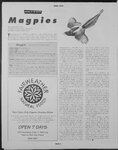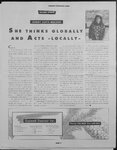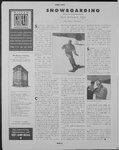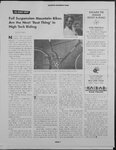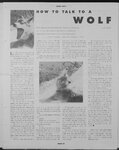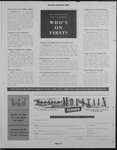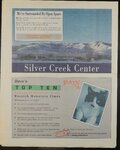| OCR Text |
Show APRIL SPECIES OF THE 1995 MONTH By Pamela Mills Poulson Manager of Environmental Education Red Butte Garden and Arboretum he meager snow of 1994-95 is rapidly melting into rushing streams. Birds and butterflies are returning from their winter retreats. Skinny herbivores are feasting on bounteous Spring-tender forage. Carnivores are devouring skinny herbivores. Mountain bikes and lawnmowers are emerging from their Magpie, Pica pica hudsonia Other Names: Tuxedo Bird, Pest Total Length: 17 to 22 inches. Tail Length: More than half the total length. Range and Distribution: From northwestern Africa across Eurasia and western North America. Common year-round residents of the Wasatch Foothills. Habitat: Brushy chapparal, and streamside thickets, with plenty of open grassy areas divided by tall, dense brush at about 5,000 feet elevation. Preferred Nesting Site: In a shrub or tree, up to 15 feet off the ground. Eggs: Greenish, blotched. sleeping places. All the while, a wise old bird perched on a snarly nest of twigs has viewed the proceedings, scolding us throughout the winter. Gliding from tree to tree, hopping along on newly fallen snow, chasing chickadees from our bird feeders, the magpie has watched us all. Magpies, who never migrate, range from northwestern Africa across Eurasia and western North Voice: America tate any A loud, other nasal, bird and or questioning, high-pitched mag? animal, mag? mag? human or Note: Can machine imi- and are year-round resi- dents of the Wasatch. In the Wasatch their preferred habitat is brushy chaparral, and streamside thickets, with plenty of open grassy areas noise. How to see one: Approach a large grove of Gabel oak in February, March or April. They'll find you. Listen for a nagging squawk. divided by tall, dense brush at about 5,000 feet elevation. They are particularly fond of nesting in mature Gambel oak (Quercus gambellii). The gnarly branching and rough bark of Gambel, or scrub oak provide magpies with much handy nest anchorage. Magpies nest while snow still covers the ground. Watch for a domed knot of twigs in a shrub or tree, up to 15 feet off the ground. Look for the largest of twig-nests in the neighborhood. This is the true nest. The other two or more are decoy nests, built to fool predators. Male and female magpies are identical and mate for life. They enlarge and repair the same nests year after year. Though usually less than two feet across, old nests up to seven feet wide have been found. Inside an active nest is a hollow interwoven with a soft lining. Ugly blotched eggs are laid one at a time over a two week period. Incubation begins before laying is completed; consequently, eggs hatch at intervals. This ensures that if food is scarce, the last chicks to hatch will starve, reducing the brood to those that can effectively survive. Dead chicks are eaten by fellow nestlings. That thought brings to mind the disgusting eating habits of magpies, the main reason so many humans dislike — no despise them. While Park City’s Only Organic Grocery Store Homemade Vegetarian Sandwiches and Soup ¢ Vitamins © Herbs e Cold and Flu Remedies © Frozen and Refrigerated Organic Products * Organic Produce * Holistic Books and Magazines Body Care * Environmentally Friendly Froducts OPEN 7 DAYS 1270 lronhorse Drive © Park City Next to Park City Glass 649-4561 PAGE 4 mom keeps naked babies warm against early Spring, dad collects and regurgitates goodies from his food pouches to feed them all. He brings the babies mostly mashed insects. Mom and he will eat just about anything, including seeds, fruit, and eggs/baby birds from other species’ nests. A favorite fare is roadkill: two week dead mule deer and flat potguts from I-80 — freshness not a concern. scrape (So, who else up lightweight is going highway to car- rion?) Magpies are recognized and despised throughout their range. In eastern Europe, the playful badboys have bounties on their glossy heads because they prey on game bird eggs and young. Traditional European folklore tells us that a magpie crossing our path as ill an omen as being crossed by a black cat. Magpies do indeed, have some nasty and annoying habits, but some of us like magpies and believe them to be one of the most interesting of birds. The Corvids are a group of birds notorious fer. conspicous personalities, keen eyesight and high intelligence. You'll never forget a magpie or mistake its behavior for any other bird. A magpie can spot an enemy entering quarter mile away. its territory from a It outwits its ene- mies with cunning and munches bacon stolen right off of our breakfast picnic tables. In flight, a magpie is simply exquisite. Watch a magpie fly and you will know how flight is done. A magpie swims, undulating through the air, with large white patches flashing in his wings, and his long tail ruddering gracefully behind. His feathers iridesce by the same trick of light that forms rainbows on oily water. Are they black? Purple? Green? Whether we call them magpies, tuxedo birds, or pesky rogues, magpies are lovable knaves worth watching. @ |



